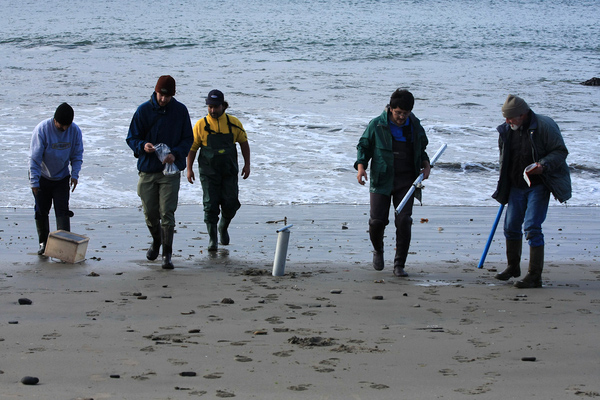Long-forgotten
coastal habitats reappeared, species unseen for years returned
 The reappearance of long-forgotten
habitats and the resurgence of species unseen for years may not be among the
expected effects of a natural disaster.
The reappearance of long-forgotten
habitats and the resurgence of species unseen for years may not be among the
expected effects of a natural disaster.
Yet that's exactly what researchers
found in a study of the sandy beaches of south central Chile, after an
8.8-magnitude earthquake and devastating tsunami in 2010.
Their study also revealed a preview of
the problems wrought by sea level rise--a major symptom of climate change.
In a scientific first, researchers from
Southern University of Chile and the University of California, Santa Barbara
(UCSB) were able to document the before-and-after ecological impacts of such
cataclysmic occurrences.
A paper appearing today in the journal
PLoS ONE details the surprising results of their study, pointing to the
potential effects of natural disasters on sandy beaches worldwide.
The study is said to be the first-ever
quantification of earthquake and tsunami effects on sandy beach ecosystems
along a tectonically active coastal zone.
"So often you think of earthquakes
as causing total devastation, and adding a tsunami on top of that is a major
catastrophe for coastal ecosystems," said Jenny Dugan, a biologist at
UCSB.
"As expected, we saw high mortality
of intertidal life on beaches and rocky shores, but the ecological recovery at
some of our sandy beach sites was remarkable.
"Plants are coming back in places
where there haven't been plants, as far as we know, for a very long time. The
earthquake created sandy beach habitat where it had been lost. This is not the
initial ecological response you might expect from a major earthquake and
tsunami."
Their findings owe a debt to
serendipity.
The researchers were knee-deep in a
study supported by FONDECYT in Chile and the U.S. National Science Foundation's
(NSF) Santa Barbara Coastal Long-Term Ecological Research (LTER) site of how
sandy beaches in Santa Barbara and south central Chile respond, ecologically,
to man-made armoring such as seawalls and rocky revetments.
By late January, 2010, they had surveyed
nine beaches in Chile.
The earthquake hit in February.
Recognizing a unique opportunity, the
scientists changed gears and within days were back on the beaches to reassess
their study sites in the catastrophe's aftermath.
They've returned many times since,
documenting the ecological recovery and long-term effects of the earthquake and
tsunami on these coastlines, in both natural and human-altered settings.
"It was fortunate that these
scientists had a research program in the right place--and at the right time--to
allow them to determine the responses of coastal species to natural
catastrophic events," said David Garrison, program director for NSF's
coastal and ocean LTER sites.
The magnitude and direction of
land-level change resulting from the earthquake and exacerbated by the tsunami
brought great effects, namely the drowning, widening and flattening of beaches.
The drowned beach areas suffered
mortality of intertidal life; the widened beaches quickly saw the return of
biota that had vanished due to the effects of coastal armoring.
"With the study in California and
Chile, we knew that building coastal defense structures, such as seawalls,
decreases beach area, and that a seawall results in the decline of intertidal
diversity," said lead paper author Eduardo Jaramillo of the Universidad
Austral de Chile.
 "But after the earthquake, where
significant continental uplift occurred, the beach area that had been lost due
to coastal armoring has now been restored," said Jaramillo. "And the
re-colonization of the mobile beach fauna was underway just weeks
afterward."
"But after the earthquake, where
significant continental uplift occurred, the beach area that had been lost due
to coastal armoring has now been restored," said Jaramillo. "And the
re-colonization of the mobile beach fauna was underway just weeks
afterward."
The findings show that the interactions
of extreme events with armored beaches can produce surprising ecological
outcomes. They also suggest that landscape alteration, including armoring, can
leave lasting footprints in coastal ecosystems.
"When someone builds a seawall,
beach habitat is covered up with the wall itself, and over time sand is lost in
front of the wall until the beach eventually drowns," said Dugan.
"The semi-dry and damp sand zones
of the upper and mid-intertidal are lost first, leaving only the wet lower
beach zones. This causes the beach to lose diversity, including birds, and to
lose ecological function."
Sandy beaches represent about 80 percent
of the open coastlines globally, said Jaramillo.
"Beaches are very good barriers
against sea level rise. They're important for recreation--and for conservation."
-NSF-






No comments:
Post a Comment